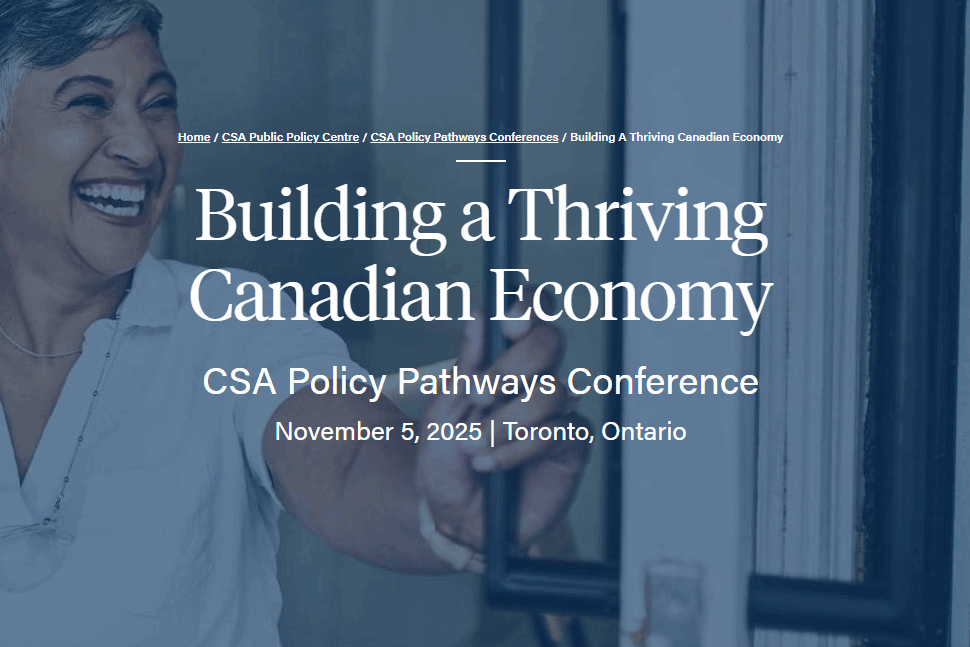By Jim Stanford | Part of our Special Series: Always Canada. Never 51. | This post first appeared in Policy Options.
Some political and business commentators argue Canada experienced a lost decade of subpar economic performance even before U.S. President Donald Trump’s erratic trade actions cast their shadow. The most common evidence presented for this pessimistic judgment is a comparison of Canada’s per capita GDP to the U.S. and other industrial countries.
To be sure, Canada’s economy has traversed many challenges in recent years, including a global pandemic and subsequent inflation. Many features of the economy need to be strengthened. But for several reasons, it is misleading to use per capita GDP to grade Canada’s overall economic performance or, as it often is used, as a proxy for measuring living standards.
Per capita GDP is a simple ratio of the total value of goods and services produced for money in an economy divided by that jurisdiction’s population. The math sounds easy. But the methodology is complicated. Equating average output per person with the standard of living in a country is not credible.
Per capita GDP has a numerator (GDP) and a denominator (population). Canada’s numerator has not performed badly by international standards. Real GDP growth over the past decade averaged close to two per cent per year, despite a shallow recession in 2015 and a bigger downturn during the COVID-19 pandemic. That’s the second fastest among G7 economies, behind only the U.S.
It’s the denominator, therefore, that explains Canada’s seemingly poor performance by this measure. GDP has grown but not as fast as the population. Indeed, in recent years, Canada has had its fastest population growth since the 1950s. The population grew three per cent in each of 2023 and 2024, almost entirely due to immigrants – two thirds of whom were non-permanent arrivals (on temporary work or student visas).
Economic averages diluted by immigration
There is much to debate about the appropriate pace of this and the federal government has recently curtailed non-permanent immigration. But the impact of rapid population growth on an arbitrary statistical ratio hardly proves a broader economic failure.
The link between immigration and GDP is indirect and felt with a time lag. We do not expect the arrival of new Canadians to immediately boost GDP in the same proportion as the existing population for many reasons. It takes time to find work, gain skills and develop productivity.
Any surge in immigration will normally result in lower average per capita GDP, but that doesn’t mean Canada’s previous residents suddenly became poorer.
It simply means that Canada is absorbing new people to lay the groundwork for future expansion. The resulting decline in per capita GDP cannot be interpreted as evidence of a more general malaise.
It is also worth noting that many of the business voices now bemoaning Canada’s per capita GDP performance were the same voices demanding more access to temporary foreign labour after COVID-19 (to solve purported labour shortages and reduce wage pressures). It’s contradictory for them to now complain about poor GDP per capita resulting precisely from the temporary immigration they demanded.
GDP itself – the numerator of the ratio – encounters numerous conceptual and methodological questions, casting further doubt on its validity as a measure of living standards. GDP includes many components that have no direct bearing on the quality of life, such as depreciation, real estate commissions and imputed rents on housing.
It is tricky to measure real GDP over time and even trickier to compare it across countries, different currencies and different prices.
Moreover, simple per capita averages ignore how GDP is distributed. Only about half of GDP is paid to workers. Much is captured in profits and investment income, disproportionately concentrated at the top of the income ladder. Very high incomes for a rich elite can pull up average GDP per capita figures, even when most members of a society face hardship.
International comparisons confirm the perils of evaluating economic performance by GDP per capita. The top four countries on the International Monetary Fund’s per capita GDP ranking are all tax havens: Luxembourg, Switzerland, Ireland and Singapore. A fifth, Liechtenstein, is not included due to incomplete data, but its GDP per capita (US$186,000) is the highest of all – helped by the fact its population is just 40,000.
These countries receive inflows of profits from global companies lured by low corporate taxes and lax banking rules. Those inflows boost GDP per capita (with profits credited to local subsidiaries of those global firms), but have little impact on work, production or living standards.
The Irish example
The Irish case is instructive. Ireland has recorded the fastest growth of real GDP per capita of any OECD country over the last decade and its GDP per capita is purportedly twice Canada’s. Ireland is a wonderful, fascinating place. But any visitor can immediately confirm it is not rich. Average living standards (evidenced by wages, housing, health and poverty) are no higher and, by some measures lower, than Canada’s.
Because Ireland’s corporate tax rate is lower than other European Union countries, global multinationals have established Irish subsidiaries to receive intracorporate transfers. In 2023, more than half of all net value added in Ireland consisted of business profits – two thirds of which belonged to foreign firms.
GDP per capita has soared but living standards have not. Because the whole model is driven by corporate tax avoidance, the Irish government’s ability to capture some of that largesse for domestic use is constrained.
The vagaries of per capita thinking are equally visible in Canada. Consider Newfoundland and Labrador. After the development of offshore oil resources in the 1990s, that province’s GDP grew rapidly. Some of the new wealth trickled down to residents, but not as much as might be assumed.
By 2006, per capita GDP in Newfoundland and Labrador exceeded the Canadian average. Its new status as a “have” province was significant beyond provincial pride. It meant that Newfoundland and Labrador soon stopped receiving federal equalization payments.
However, personal incomes in the province remained below national averages. Over the latest five years, Newfoundland and Labrador’s GDP per capita was 6.1 per cent higher than the Canadian average, yet personal income per capita (including government transfer programs) was 3.4 per cent lower.
Exacerbating this anomaly, Newfoundland and Labrador’s population shrank through the 2000s. Population decline is negative for any economy, but it has the perverse effect of artificially boosting GDP per capita (by shrinking the denominator). This further eroded the province’s chances of receiving equalization.
Much of the GDP associated with offshore oil literally never touches ground in the province. It is shipped overseas by tanker, with most of the profits appropriated by petroleum firms headquartered on the mainland or in other countries. Because of this, the province’s GDP is skewed heavily toward corporate profit. That’s good for business but doesn’t enrich its residents.
Little wonder then that the province is challenging the federal equalization formula in court. Last year, shrinking oil revenues pushed the province’s GDP per capita back slightly below the Canadian average, so Newfoundland and Labrador will now receive (small) equalization payments once again. But this experience confirms per capita GDP is no way to measure the true well-being of a province or a country.
The goal of economic policy is not to maximize an abstract statistic. It should be to enhance the well-being of people. Per capita GDP is not an accurate or reliable measure of progress toward that goal.
—
This is part 1 of a 2-part analysis. In part 2, Jim Stanford evaluates per capita GDP comparisons between Canada and the U.S. This article originally appeared in Policy Options. It is republished here under a Creative Commons license.
🎥 Plus, view Social Capital Partners’ video: Is Canada really poorer than Alabama?
Share with a friend
Related reading
Pipelines and algorithms aren’t going to save us | The Hill Times
Smart investments in natural resources and AI alone will not get us through this moment of geopolitical rupture. As Matthew Mendelsohn writes in an op-ed for The Hill Times, SMEs contribute just over half of Canada’s GDP and employ 64 per cent of our people. We have to make more low-cost capital available to the smaller businesses, locally owned enterprises, not-for-profits and social enterprises who crucially employ and reinvest locally, act as important local economic infrastructure and provide services that are crucial for well-being. They are automatic stabilizers in the face of tariff threats outside our control.
What’s wrong with mainstream economics?
Mainstream, or “neoclassical,” economics still dominates how we teach, study and understand our economy, even though much of it doesn’t match reality. In this piece, economists Louis-Philippe Rochon and Guillaume Vallet explain why outdated economic ideas persist and how they can lead to harmful policies. They challenge five common myths about inflation, growth and inequality, showing that today’s economy is driven more by power and institutions than by perfect markets. As "heterodox" economists, they argue it's time for a new kind of economics that reflects how the real world actually works.
Building a thriving economy: CSA Policy Pathways Conference
The CSA Policy Pathways Conference convenes leaders, thinkers and changemakers across government, business, community and academia to confront the pressing questions shaping our economic future. How can we build resilience in the face of global uncertainty? What will it take to unlock innovation and ensure its benefits are broadly shared? How do we design policies that promote competition, inclusion, and financial security? Join us on November 5, 2025, in Toronto, as we explore how we can take bolder steps toward a more resilient, innovative and equitable economic future.


